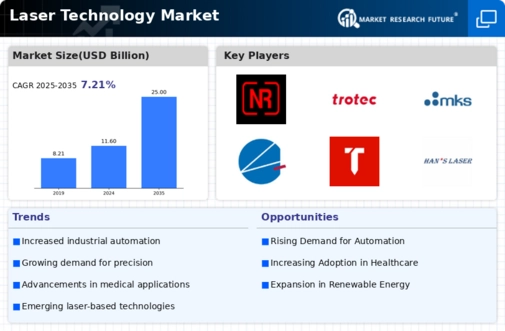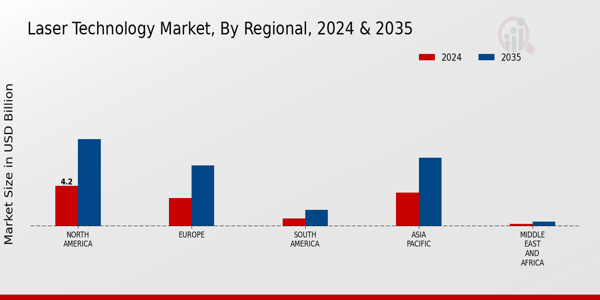Technological Advancements
Technological innovations play a pivotal role in shaping the Global Laser Technology Market Industry. Continuous advancements in laser design, efficiency, and functionality have led to the development of more sophisticated laser systems. For example, the introduction of fiber lasers has significantly improved cutting speeds and quality in industrial applications. These advancements not only enhance productivity but also reduce operational costs, making laser technology more accessible to various industries. The anticipated compound annual growth rate (CAGR) of 7.21% from 2025 to 2035 further underscores the potential for growth driven by ongoing technological enhancements.
Market Trends and Projections
Expansion of End-User Industries
The expansion of end-user industries significantly influences the Global Laser Technology Market Industry. Sectors such as automotive, aerospace, and electronics are increasingly integrating laser technologies into their production processes. This integration enhances precision and efficiency, thereby improving overall product quality. For instance, the automotive industry utilizes laser welding for lightweight vehicle designs, contributing to fuel efficiency. As these industries continue to grow and evolve, the demand for laser solutions is expected to rise correspondingly. This trend is indicative of the broader adoption of laser technologies across various sectors, further solidifying the market's growth potential.
Growing Focus on Energy Efficiency
The Global Laser Technology Market Industry is witnessing a growing emphasis on energy efficiency, driven by environmental concerns and regulatory pressures. Laser technologies are increasingly recognized for their ability to minimize energy consumption compared to traditional manufacturing processes. For example, laser cutting and welding techniques often require less energy and generate less waste, aligning with sustainability goals. This shift towards energy-efficient solutions is likely to attract investments and drive market growth. As industries seek to reduce their carbon footprint, the adoption of laser technologies is expected to rise, further propelling the market forward.
Rising Demand for Laser Applications
The Global Laser Technology Market Industry experiences a notable surge in demand across various sectors, including manufacturing, healthcare, and telecommunications. This demand is driven by the increasing adoption of laser technology for precision cutting, welding, and medical procedures. For instance, the use of lasers in surgical applications has revolutionized patient care, enhancing recovery times and reducing complications. As of 2024, the market is valued at approximately 11.6 USD Billion, reflecting the growing reliance on laser solutions. This trend is expected to continue, with projections indicating that the market could reach 25 USD Billion by 2035, showcasing a robust growth trajectory.
Increased Investment in Research and Development
Investment in research and development (R&D) is a critical driver for the Global Laser Technology Market Industry. Governments and private entities are increasingly allocating funds to explore new applications and improve existing laser technologies. This focus on R&D fosters innovation, leading to the emergence of novel laser solutions that cater to diverse industrial needs. For instance, advancements in laser-based communication systems are enhancing data transmission speeds and reliability. As the market evolves, the emphasis on R&D is likely to yield breakthroughs that could redefine industry standards and expand the scope of laser applications.






















